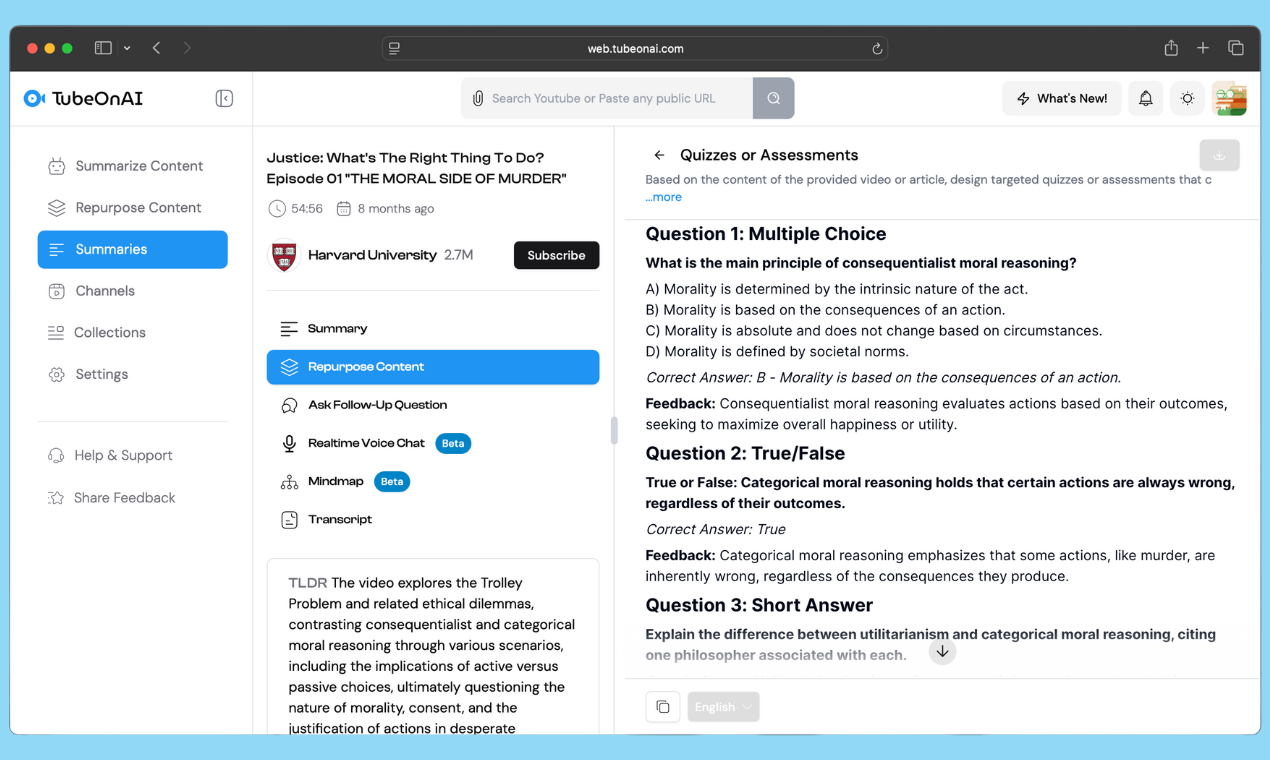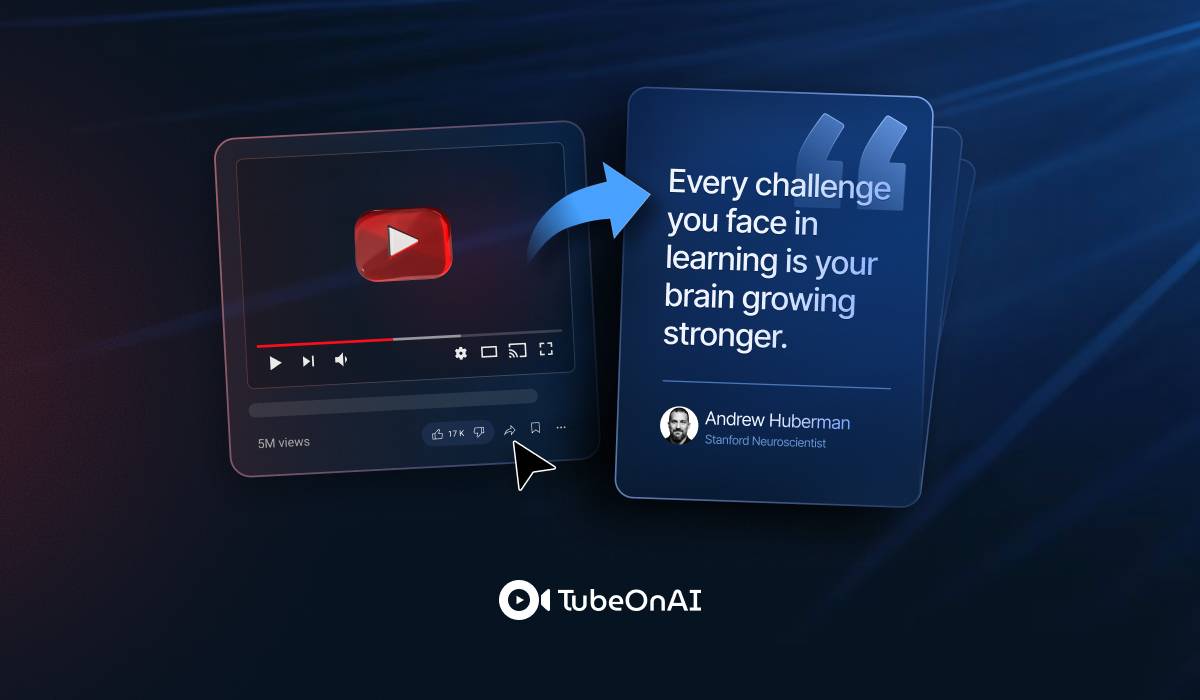YouTube quote citation is the academic process of finding specific statements, extracting exact verbal content, and properly attributing quoted material from YouTube videos in scholarly writing.
Unlike citing entire videos as sources, quote citation requires precise timestamp identification, verbatim transcription accuracy, and specific formatting that directs readers to the exact moment when speakers make particular statements.
Why Accurate Quote Extraction from YouTube Videos Matters
When researchers, students, and academics quote specific statements from YouTube videos, they accomplish critical scholarly objectives:
- Precise Evidence: Direct quotes provide exact expert statements supporting arguments
- Timestamp Accuracy: Specific time markers enable readers to verify quoted content
- Speaker Attribution: Proper quote citation credits original speakers and maintains academic integrity
- Research Verification: Accurate quotes allow peer review and source validation
- Expert Authority: Citing specific expert statements strengthens academic credibility
[APA, MLA, Chicago] Citation Styles to Follow While Citing Quotes from a YouTube Video
The format for your citation depends on the style guide required by your institution or publication. The three most common styles are MLA, APA, and Chicago.
For any video citation, you will typically need the creator’s name (or channel name), the video title, the name of the website (YouTube), the publication date, and the URL.
A crucial element for citing a quote from a video is the timestamp. Since videos don’t have page numbers, a timestamp (e.g., 00:02:15) directs your reader to the exact moment the quote is spoken.
Let’s use a hypothetical example video to demonstrate each style:
- Creator/Channel: Dr. Alisha Rai
- Video Title: The Quantum Leap in Machine Learning
- Publication Date: September 10, 2025
- URL: https://www.youtube.com/watch?v=123xyz
1. MLA 9th Edition Format for Video Quotes
The Modern Language Association (MLA) style is commonly used in the humanities. It emphasizes the creator’s name.
Works Cited Format:
Creator’s Last Name, First Name (or Channel Name). “Title of the Video.” YouTube, uploaded by [Channel Name if different from creator], Day Month Year, URL.7
Works Cited Example:
Rai, Alisha. “The Quantum Leap in Machine Learning.” YouTube, 10 Sept. 2025, https://www.youtube.com/watch?v=123xyz.
In-Text Citation with Quote and Timestamp:
When you use the quote in your writing, place the creator’s name and the timestamp range in parentheses at the end of the sentence.
Example Sentence: “Dr. Rai argues that early AI models were “merely sophisticated calculators, not thinking machines” (Rai 00:04:31-00:04:35).”
2. APA 7th Edition Format for Video Quotes
APA (American Psychological Association) style is prevalent in the social sciences. It prioritizes the publication date.
Reference List Format
Creator’s Last Name, F. (or Channel Name). (Year, Month Day). Title of the video [Video]. YouTube. URL
Reference List Example:
Rai, A. (2025, September 10). The quantum leap in machine learning [Video]. YouTube. https://www.youtube.com/watch?v=123xyz
In-Text Citation with Quote and Timestamp
The in-text citation includes the author’s last name, the year, and the timestamp.9
Example Sentence:
One expert claimed that early AI models were “merely sophisticated calculators, not thinking machines” (Rai, 2025, 4:31).
3. Chicago Manual of Style (17th Edition – Notes and Bibliography)
The Chicago style is often used in history and the arts. It offers flexibility with footnotes or endnotes.
Bibliography Format
Creator’s Last Name, First Name (or Channel Name). “Title of Video.” YouTube video, length. Posted Month Day, Year. URL.
Bibliography Example:
Rai, Alisha. “The Quantum Leap in Machine Learning.” YouTube video, 15:22. Posted September 10, 2025. https://www.youtube.com/watch?v=123xyz.
Footnote Format
The first time you cite the source, you use a full note. Subsequent citations can use a shortened note.
footnote Example:
¹ Alisha Rai, “The Quantum Leap in Machine Learning,” YouTube video, 15:22, posted September 10, 2025, https://www.youtube.com/watch?v=123xyz, 4:31.
The Challenge of Finding Exact Quotes in Long Videos
Traditional quote extraction from YouTube videos presents significant challenges:
- Time-Intensive Search: Manually scrubbing through hour-long lectures to find specific statements
- Transcription Errors: Hand-typing quotes while pausing and replaying video segments
- Timestamp Precision: Recording exact start and end times for quoted material
- Audio Quality Issues: Dealing with unclear speech, accents, or background noise
- Context Verification: Ensuring quotes maintain original speaker meaning and context
Modern AI-powered quote extraction tools have revolutionized this process, offering automated transcription, intelligent quote search, and precise timestamp identification for academic quote citation.
Easiest Way to Cite a Quote from a YouTube Video Using AI
Mastering the manual citation formats is essential, but the process of finding the perfect quote within a long video can be daunting.
Advanced AI platforms like TubeonAI have transformed quote extraction by enabling conversational search within video content, automated transcription analysis, and intelligent quote identification.
Here is a step-by-step tutorial on using this powerful feature:

Step 1: Generate an Instant Summary
Begin by pasting the YouTube video’s URL into TubeonAI. The tool will first provide a concise, high-quality summary of the video. This initial step is invaluable, as it allows you to quickly grasp the video’s main arguments and confirm that it’s relevant to your work before you even look for a specific quote.
Step 2: Ask Follow-up Questions to Find the Quote
Use AI chat interfaces to search for specific quotes using natural language queries instead of manually scanning transcripts:
Effective Quote Search Queries:
“Find where the researcher mentions ‘sophisticated calculators'”
“Find the exact quote where the speaker discusses AI limitations”
“What did the expert say specifically about machine learning bias?”
“Locate the statement about future technology predictions in 2030”
“Extract the quote comparing traditional methods to new approaches”
Step 3: Precise Quote Extraction with Timestamp Verification
AI systems provide:
- Surrounding Context: Additional sentences before and after for context understanding
- Verbatim Quote Text: Exact words spoken by the original speaker
- Precise Timestamps: Start and end times for quoted material (e.g., 00:04:31-00:04:35)
- Speaker Context: Information about who made the statement and their credentials
Step 4: Format and Integrate Your Citation
With the perfect quote delivered to you by the AI, you have everything you need. Simply copy this information and use it to build your formal citation according to your required style (MLA, APA, or Chicago).
Place the quote in your document and add the corresponding in-text citation, confident in its accuracy. This method transforms a tedious research task into a simple, interactive conversation.
Best Practices for Accurate YouTube Quote Citation
Following the correct format is only half the battle. To maintain high academic standards, adhere to these best practices:
Ensuring Quote Accuracy and Transcription Precision
- Verbatim Accuracy: Quote exactly as spoken, including grammar and pronunciation variations
- Complete Statements: Include full sentences or complete thoughts, not partial phrases
- Context Preservation: Ensure quotes maintain original speaker intent and meaning
- Punctuation Clarity: Add necessary punctuation for readability while preserving original meaning
- Speaker Attribution: Clearly identify who made the statement and their expertise
Timestamp Precision and Formatting Standards
- Precise Timing: Use exact seconds for quote start and end times
- Range Formatting: For longer quotes, use start-end format (00:04:31-00:04:35)
- Single Point: For brief statements, single timestamp acceptable (4:31)
- Verification Method: Always test timestamps to ensure accuracy for readers
- Multiple Quotes: Use semicolons to separate multiple timestamps (4:31; 7:22; 10:15)
Quote Context and Integration Strategies
According to Dr. Sarah Chen, a machine learning researcher at Stanford, "artificial intelligence systems require careful ethical consideration" (Chen 00:12:45).Context-Setting Examples:
- “During her keynote address on AI ethics, Dr. Chen emphasized that…”
- “When discussing future technology implications, the expert stated…”
- “In response to questions about current limitations, the researcher explained…”
Post-Quote Analysis Integration:
- Relate quoted content to your thesis or research questions
- Explain quote relevance to your research argument
- Connect expert statement to broader academic literature
- Address potential counterarguments or limitations
Tips for Extracting Quotes from Different Video Types
Academic Lecture Quote Extraction
Characteristics: Structured presentations, clear speakers, educational content
Best Practices: Focus on key concepts, definitions, research findings
Example Topics: Thesis statements, research conclusions, expert definitions
Expert Interview Quote Extraction
Characteristics: Conversational format, opinion-based content, personal insights
Best Practices: Identify authoritative statements, professional experience, industry predictions
Example Topics: Professional opinions, industry trends, expert recommendations
Conference Presentation Quote Extraction
Characteristics: Formal presentations, research findings, professional discussions
Best Practices: Extract research conclusions, statistical findings, future predictions
Example Topics: Study results, methodology explanations, implications discussions
Panel Discussion Quote Extraction
Characteristics: Multiple speakers, interactive dialogue, diverse perspectives
Best Practices: Clearly attribute speakers, maintain context, note disagreements
Example Topics: Comparative viewpoints, debate positions, consensus statements
Common Mistakes in YouTube Quote Citation
Using YouTube’s often-inaccurate automatic captions. Citing incomplete statements without full context. Providing approximate rather than exact timing. Incorrectly identifying who made specific statements. Using quotes out of original context or meaning
Prevention Strategies:
- Always verify quotes against original audio
- Use professional transcription tools for critical quotes
- Maintain speaker context and attribution accuracy
- Provide sufficient surrounding context for quote understanding
Citation Format and Academic Standards Issues
- Inconsistent Timestamp Formatting: Mixing different time formats within papers
- Missing Speaker Information: Failing to identify quote speakers and credentials
- Incomplete Citations: Omitting essential elements like URLs or publication dates
- Style Guide Violations: Mixing MLA, APA, and Chicago format requirements
- Inadequate Quote Integration: Dropping quotes without proper introduction or analysis
Frequently Asked Questions (FAQs)
1. How do I cite a YouTube video if the creator uses a username instead of a real name?
You should cite the channel name or username exactly as it appears on the channel. For example, if the channel is named “TechInFive,” you would use that as the creator’s name in the citation.
2. What should I do if the video has no clear publication date?
If a date is not available, use the abbreviation “n.d.” (for “no date”) in place of the date in your citation.
3. Do I need to cite a comment from a YouTube video?
Yes, if you are quoting a comment, you should cite it. The format is slightly different, often treating it as a personal communication or online post. Typically, you would describe it as “Comment on the video ‘[Video Title]'” and include the commenter’s username, the date of the comment, and the URL of the video.12
4. Can I just include the link to the video in my text?
Simply hyperlinking the video is not sufficient for academic or professional writing. A formal citation provides essential metadata (creator, date, title) that a simple link lacks and ensures the source can be traced even if the link breaks.
5. How do I cite a video if I am quoting the text that appears on the screen, not spoken words?
You would cite it the same way, using a timestamp to indicate when the text appears. In your writing, you can clarify by stating, “As shown in the on-screen text at 00:03:22…”
6. How do I find a specific quote when I remember the general topic but not the exact words?
Use AI-powered search tools with natural language queries describing the concept:
- “Find the quote about AI replacing human jobs”
- “Locate the statement discussing climate change solutions”
- “Extract the opinion about social media impact on teenagers”
These tools can identify relevant quotes based on topical concepts rather than exact word matching.
7. What’s the difference between citing a quote and citing paraphrased content from YouTube videos?
Direct Quotes:
- Require exact transcription and quotation marks
- Need precise timestamps for verification
- Demand verbatim accuracy and speaker attribution
- Used when specific wording is crucial for your argument
Paraphrased Content:
- Summarize speaker ideas in your own words
- Still require citation and timestamps for reference
- Allow for clearer integration with your writing style
- Useful when concepts matter more than exact phrasing
Example:
Direct Quote: Dr. Rai stated that “artificial intelligence systems are merely sophisticated calculators, not thinking machines” (Rai 4:31).
Paraphrase: Dr. Rai argued that current AI technology lacks true cognitive abilities and functions more like advanced computational tools than conscious entities (Rai 4:31).

